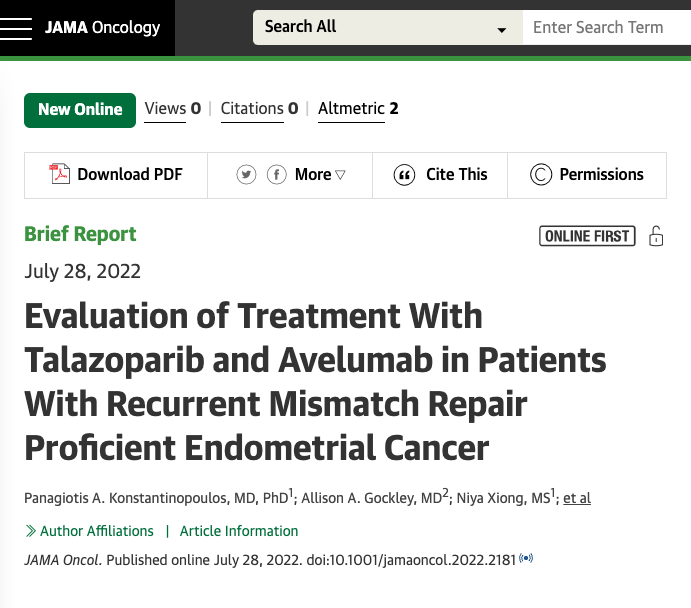Jama Sub -journal: 15 years of quitting smoking, the risk of lung cancer is still high
Author:Cancer Channel of the Medical Time:2022.08.01
*For medical professionals for reading reference

1 minute every day, give you the professional "talk" in the tumor circle! (If the original text is required, you can add Xiaobian WeChat yxj_oncology)
Summary:
1. Jama Subcurement: The risk of lung cancer is not recommended for smokers who are not recommended for annual screening
2. JAMA Subcurement: Talazoparib and AVELUMAB to treat recurrent mismatches to repair defective endometrium cancer safe and effective
1
JAMA Sub -Journal: The risk of lung cancer is not recommended for smokers who are not recommended for annual screening
▎ Clinical issue:
What is the risk of lung cancer without being recommended to perform low -dose computers scanning and screening every year?
The US prevention service group does not recommend adults aged 50-80 to scan lung cancer with a low-dose computer fault scan (LDCT) each year. These adults have smoked more than 20 packs per year, but they have been smoking for 15 years or longer, or or longer, or longer, or longer, or longer, or longer, or longer, or longer, or longer, or longer, or longer, or longer, or longer, or longer, or longer, they have been quitting for 15 years or longer. Now smoking is less than 20 packs/year. Among the smokers who are not recommended every year, the risk of lung cancer is not clear.
A queue published in the Jama sub -magazine shows that there is a high risk of lung cancer among smokers who do not recommend LDCT screening.

▎ Research plan:
In this queue, a data set from Cardiovascular Health Research (CHS) from the National Cardiopulmonary Hematology Research Institute. From June 1989 to June 1993, CHS recruited 5,888 community residents of 5,888 in the United States and collected a large number of smoking history base line data. At present, the analysis is limited to 4279 cancer -free subjects, and it has the baseline data of bag/year smoking history and the duration of smoking quitting. The current analysis is conducted from January 7, 2022 to May 25, 2022.
▎ Main discovery:
(1) Among the 861 non -severe smokers (<20 packs/year), 615 quit smoking for 15 years and above and 146 quit smoking below 15 years of smoking and 100 current smokers. IQR is 7.6. (3.3-13.5) package/year, 10.0 (5.3-14.9) package/year, and 11.4 (7.3-14.4) package/year.
(2) Among the 1445 heavy smokers (20 packs or more/year), 516 quit smoking 15 years or more than 15 years and 497 quit smoking below 15 years and 432 current smoking history IQR It is 34.8 (26.3-48.0) package/year, 48.0 (35.0-70.0) package/year and 48.8 (31.6-57.0) package/year.
(3) In 1973, 10 of those who did not smoke (0.5%) of lung cancer, and 5 of the current smokers with less than 20 packs/year of smoking time (5.0%) of lung cancer and 516 smoking time exceeded more than more than. There were 26 former smokers (5.0%) of the 20 -year/year -old quit smoking and more than 15 years of quit.
(4) Compared with those who never smoke, in the two groups that do not recommend LDCT, the current non -severe smokers and the incidence of the incidence of lung cancer in the first 15 years of abstinence and quit smoking are 10.54, respectively (HR), respectively (95%CI, 3.60-30.83) and 11.19 (95%CI, 5.40-23.21);
(5) Compared with those who never smoke, the current non-severe smokers and the age, gender, and racial adjustment of the former smokers who are less than 15 years of abstinence are 10.06 (95%CI, 3.41-29.70) and 10.22 (95%CI, 3.41-29.70) 4.86-21.50).
▎ Looking out:
The results of this queue study show that there is a high risk of lung cancer among smokers who are not recommended to perform LDCT screening, which indicates that predictive models need to be established to identify the high -risk sub -groups of these smokers for screening.
references:
[1] https://jamnetwork.com/journals/jamaonCology/Fullarticle/2794805
2
JAMA Sub -Journal: Talazoparib and AVELUMAB to treat recurrence mismatches repair defective endometrial cancer safety and effective
▎ Clinical issue:
Although the activity of the active activity of Parbie Mupage and Lenvetini (the only mismatch repair repaired defective endometrium cancer immunotherapy) in the US Food and Drug Administration is convincing, most patient Drugs are not tolerated, response or tolerance for this scheme. Among patients with endometrial cancer (MMRP EC) patients with defective mismatches, the combination of polycosine dilate polymerase and immune examination points in combination is not clear and safe.
A study from the Jama sub -magazine showed that Talazoparib and AVELUMAB were safe and effective for the treatment of MMRP EC.

▎ Research plan:
The researcher conducted non -random, open labels, one -arm, 2 stages, and phase 2 stages of the United States in the United States. The main qualification standards include measurable diseases, unlimited past treatment, and all endometrial cancer (EC) histological studies. Patients take 1MG TALAZOPARIB daily; 10mg/kg Avelumab is injected every 2 weeks to advance until the disease progresses or unacceptable toxic reactions. Statistics have considered the two main targets of the objective relief rate (ORR) and the 6 -monthless survival (PFS) rate (PFS). The two -stage design is used to allow early termination of treatment due to invalid. Pre -specified exploration targets include the correlation between immune genome characteristics (determined by the second -generation sequencing and immunohistochemistry through targeted panels). ▎ Main discovery:
(1) 35 female patients [average age (SD) 67.9 years (8.41)] received scheme treatment; 9 cases (25.7%) obtained clinical benefits after meeting at least one of the two main end points. Four patients (11.4%) showed clear ORR (4 cases of alleviation), and 8 (22.9%) survived without progress in 6 months.
(2) The most common toxic reactions of the most common level 3 and level 4 are anemia [16 cases (46%)], reduced platelet decrease [10 cases (29%)] and a decrease in neutral granulocytes [4 cases (11%)] ; No patient stops receiving treatment due to toxic reactions.
(3) Tumors with homologous reorganization repair are related to the clinical benefits of AVELUMAB and Talazoparib therapy. Tumor mutation load, tumor infiltration lymphocytes and PD-L1 status have nothing to do with clinical benefits.
▎ Looking out:
In summary, the analysis of immunogenic genomes provides insights on the research on the combination of endometrial cancer on the combination of endometrial cancer on the combination of polypeinosine di-phosphate and PD-L1 inhibitors.
references:
[1] https://jamnetwork.com/journals/jamaonCology/Fullarticle/2794808
The top issue of the clinical literature is on the line.
- END -
Zhumadian: Features of characteristic planting

Reporter Ding JipoRecently, the reporter walked into the Fengqiu Ecological Gourd ...
Xiamen found 7 confirmed cases in the isolated persons, all of which were reported by reporting cases on July 30

The reporter learned from the Municipal prevention and control office that from 0:...